torque CHRYSLER VOYAGER 1996 Owner's Manual
[x] Cancel search | Manufacturer: CHRYSLER, Model Year: 1996, Model line: VOYAGER, Model: CHRYSLER VOYAGER 1996Pages: 1938, PDF Size: 55.84 MB
Page 62 of 1938
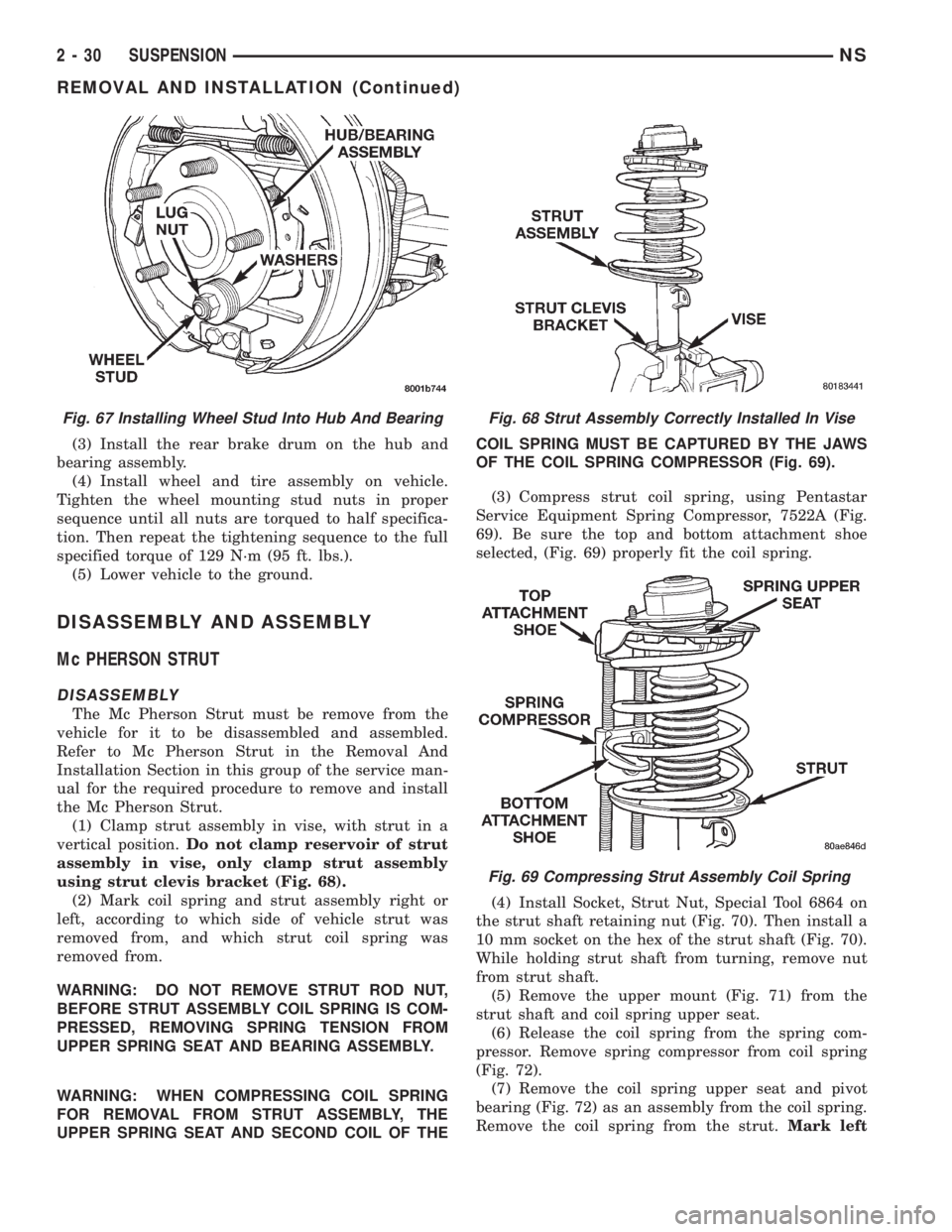
(3) Install the rear brake drum on the hub and
bearing assembly.
(4) Install wheel and tire assembly on vehicle.
Tighten the wheel mounting stud nuts in proper
sequence until all nuts are torqued to half specifica-
tion. Then repeat the tightening sequence to the full
specified torque of 129 N´m (95 ft. lbs.).
(5) Lower vehicle to the ground.
DISASSEMBLY AND ASSEMBLY
Mc PHERSON STRUT
DISASSEMBLY
The Mc Pherson Strut must be remove from the
vehicle for it to be disassembled and assembled.
Refer to Mc Pherson Strut in the Removal And
Installation Section in this group of the service man-
ual for the required procedure to remove and install
the Mc Pherson Strut.
(1) Clamp strut assembly in vise, with strut in a
vertical position.Do not clamp reservoir of strut
assembly in vise, only clamp strut assembly
using strut clevis bracket (Fig. 68).
(2) Mark coil spring and strut assembly right or
left, according to which side of vehicle strut was
removed from, and which strut coil spring was
removed from.
WARNING: DO NOT REMOVE STRUT ROD NUT,
BEFORE STRUT ASSEMBLY COIL SPRING IS COM-
PRESSED, REMOVING SPRING TENSION FROM
UPPER SPRING SEAT AND BEARING ASSEMBLY.
WARNING: WHEN COMPRESSING COIL SPRING
FOR REMOVAL FROM STRUT ASSEMBLY, THE
UPPER SPRING SEAT AND SECOND COIL OF THECOIL SPRING MUST BE CAPTURED BY THE JAWS
OF THE COIL SPRING COMPRESSOR (Fig. 69).
(3) Compress strut coil spring, using Pentastar
Service Equipment Spring Compressor, 7522A (Fig.
69). Be sure the top and bottom attachment shoe
selected, (Fig. 69) properly fit the coil spring.
(4) Install Socket, Strut Nut, Special Tool 6864 on
the strut shaft retaining nut (Fig. 70). Then install a
10 mm socket on the hex of the strut shaft (Fig. 70).
While holding strut shaft from turning, remove nut
from strut shaft.
(5) Remove the upper mount (Fig. 71) from the
strut shaft and coil spring upper seat.
(6) Release the coil spring from the spring com-
pressor. Remove spring compressor from coil spring
(Fig. 72).
(7) Remove the coil spring upper seat and pivot
bearing (Fig. 72) as an assembly from the coil spring.
Remove the coil spring from the strut.Mark left
Fig. 67 Installing Wheel Stud Into Hub And BearingFig. 68 Strut Assembly Correctly Installed In Vise
Fig. 69 Compressing Strut Assembly Coil Spring
2 - 30 SUSPENSIONNS
REMOVAL AND INSTALLATION (Continued)
Page 65 of 1938

(10) Install Socket, Strut Nut, Special Tool 6864 on
the strut shaft retaining nut (Fig. 70). Then install a
10 mm socket on the hex of the strut damper shaft
(Fig. 70). While holding strut shaft from turning,
torque strut shaft retaining nut to 94 N´m (70 ft.
lbs.).
(11) Loosen spring compressor until top coil of
spring is fully seated against upper spring seat. Then
relieve all tension from spring compressor and
remove spring compressor from strut spring.
(12) Install strut back in vehicle. Refer to Mc
Pherson Strut in the Removal And Installation Sec-
tion in this group of the service manual for the
required procedure to install the Mc Pherson Strut.
BALL JOINT SEAL BOOT
REMOVE
(1) Using a screw driver or other suitable tool, pry
the seal boot off of the ball joint assembly (Fig. 79)
INSTALL
CAUTION: When installing the ball joint seal on the
ball joint/lower control arm, the shield (Fig. 80) on
the ball joint seal must be positioned as shown.
(1) Install aNEWseal boot by hand as far as pos-
sible on the ball joint. Installation of the seal boot is
to be with the shield positioned as shown (Fig. 80).
CAUTION: Do not use an arbor press to install the
sealing boot on the ball joint. Damage to the seal-
ing boot will occur if excessive pressure is applied
to the sealing boot when it is being installed.
(2) Place Installer, Special Tool 6758 over seal boot
and squarely align it with bottom edge of seal boot
(Fig. 81). Apply hand pressure to Special Tool 6758
until seal boot is pressed squarely against top surface
of lower control arm.
CAUTION: A replacement ball joint is not prelubri-
cated. Properly lubricate the replacement ball joint
using Mopar Multi±Mile grease or an equivalent.
Lubricate ball joint after seal boot is installed but
prior to top of seal boot being pushed down below
notch in ball joint stud. Air must vent out of the
seal boot at notch when grease is pumped into ball
joint, failure to do so will balloon and damage seal
boot. Do not over grease the ball joint, this will pre-
vent the seal boot from pushing down on the stud
of the ball joint.
CAUTION: After the ball joint is properly greased,
clip the end of the grease fitting off below the hex.
The ball joint seal boot is non-purgeable and further
greasing is not required and can result in damage
to the seal boot.
Fig. 78 Installing Pivot Bearing On Upper Spring
Seat
Fig. 79 Ball Joint Seal Boot Removal
Fig. 80 Ball Joint Seal Boot Installed Position
NSSUSPENSION 2 - 33
DISASSEMBLY AND ASSEMBLY (Continued)
Page 68 of 1938
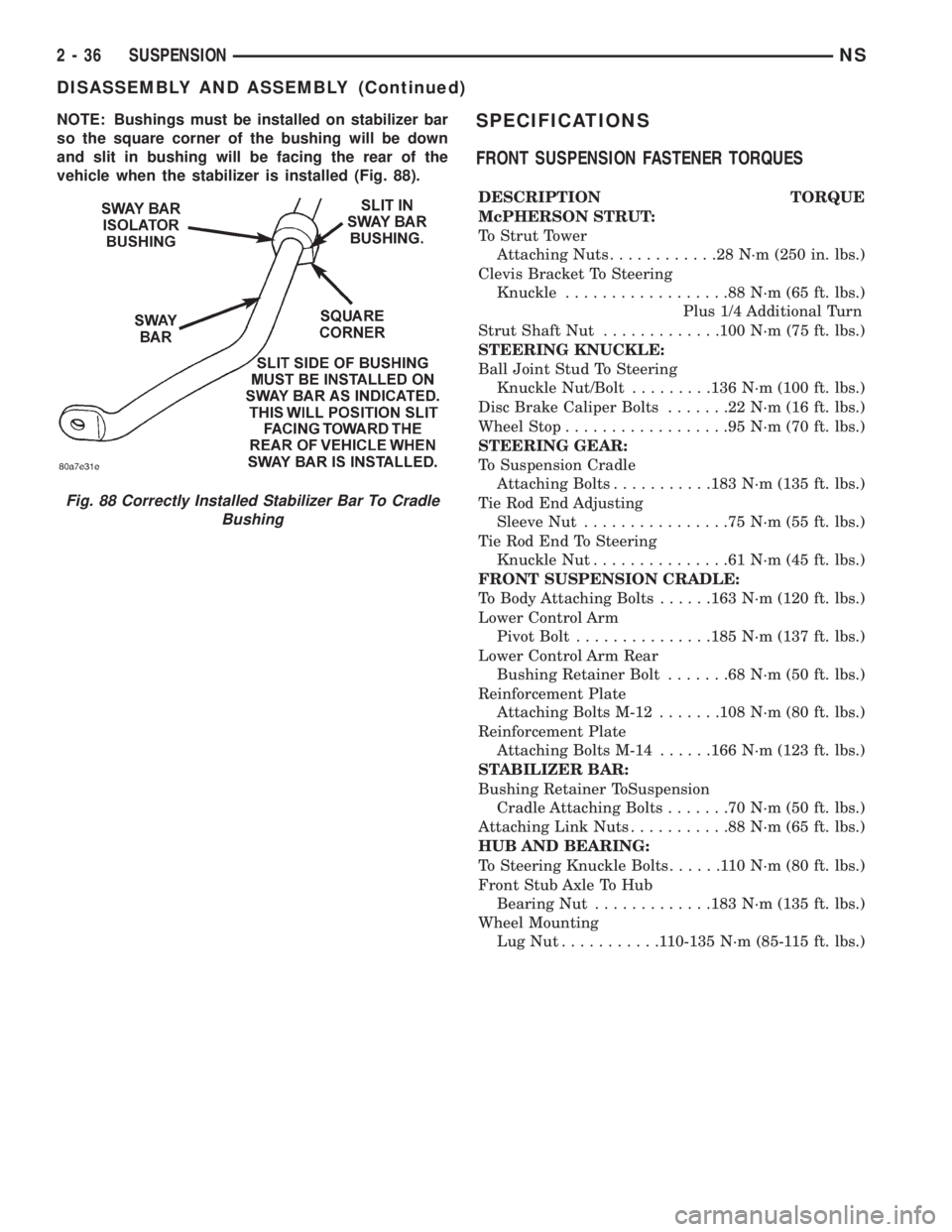
NOTE: Bushings must be installed on stabilizer bar
so the square corner of the bushing will be down
and slit in bushing will be facing the rear of the
vehicle when the stabilizer is installed (Fig. 88).SPECIFICATIONS
FRONT SUSPENSION FASTENER TORQUES
DESCRIPTION TORQUE
McPHERSON STRUT:
To Strut Tower
Attaching Nuts............28N´m(250 in. lbs.)
Clevis Bracket To Steering
Knuckle..................88N´m(65ft.lbs.)
Plus 1/4 Additional Turn
Strut Shaft Nut.............100 N´m (75 ft. lbs.)
STEERING KNUCKLE:
Ball Joint Stud To Steering
Knuckle Nut/Bolt.........136 N´m (100 ft. lbs.)
Disc Brake Caliper Bolts.......22N´m(16ft.lbs.)
Wheel Stop..................95N´m(70ft.lbs.)
STEERING GEAR:
To Suspension Cradle
Attaching Bolts...........183 N´m (135 ft. lbs.)
Tie Rod End Adjusting
Sleeve Nut................75N´m(55ft.lbs.)
Tie Rod End To Steering
Knuckle Nut...............61N´m(45ft.lbs.)
FRONT SUSPENSION CRADLE:
To Body Attaching Bolts......163 N´m (120 ft. lbs.)
Lower Control Arm
Pivot Bolt...............185 N´m (137 ft. lbs.)
Lower Control Arm Rear
Bushing Retainer Bolt.......68N´m(50ft.lbs.)
Reinforcement Plate
Attaching Bolts M-12.......108 N´m (80 ft. lbs.)
Reinforcement Plate
Attaching Bolts M-14......166 N´m (123 ft. lbs.)
STABILIZER BAR:
Bushing Retainer ToSuspension
Cradle Attaching Bolts.......70N´m(50ft.lbs.)
Attaching Link Nuts...........88N´m(65ft.lbs.)
HUB AND BEARING:
To Steering Knuckle Bolts......110N´m(80ft.lbs.)
Front Stub Axle To Hub
Bearing Nut.............183 N´m (135 ft. lbs.)
Wheel Mounting
LugNut...........110-135 N´m (85-115 ft. lbs.)
Fig. 88 Correctly Installed Stabilizer Bar To Cradle
Bushing
2 - 36 SUSPENSIONNS
DISASSEMBLY AND ASSEMBLY (Continued)
Page 70 of 1938
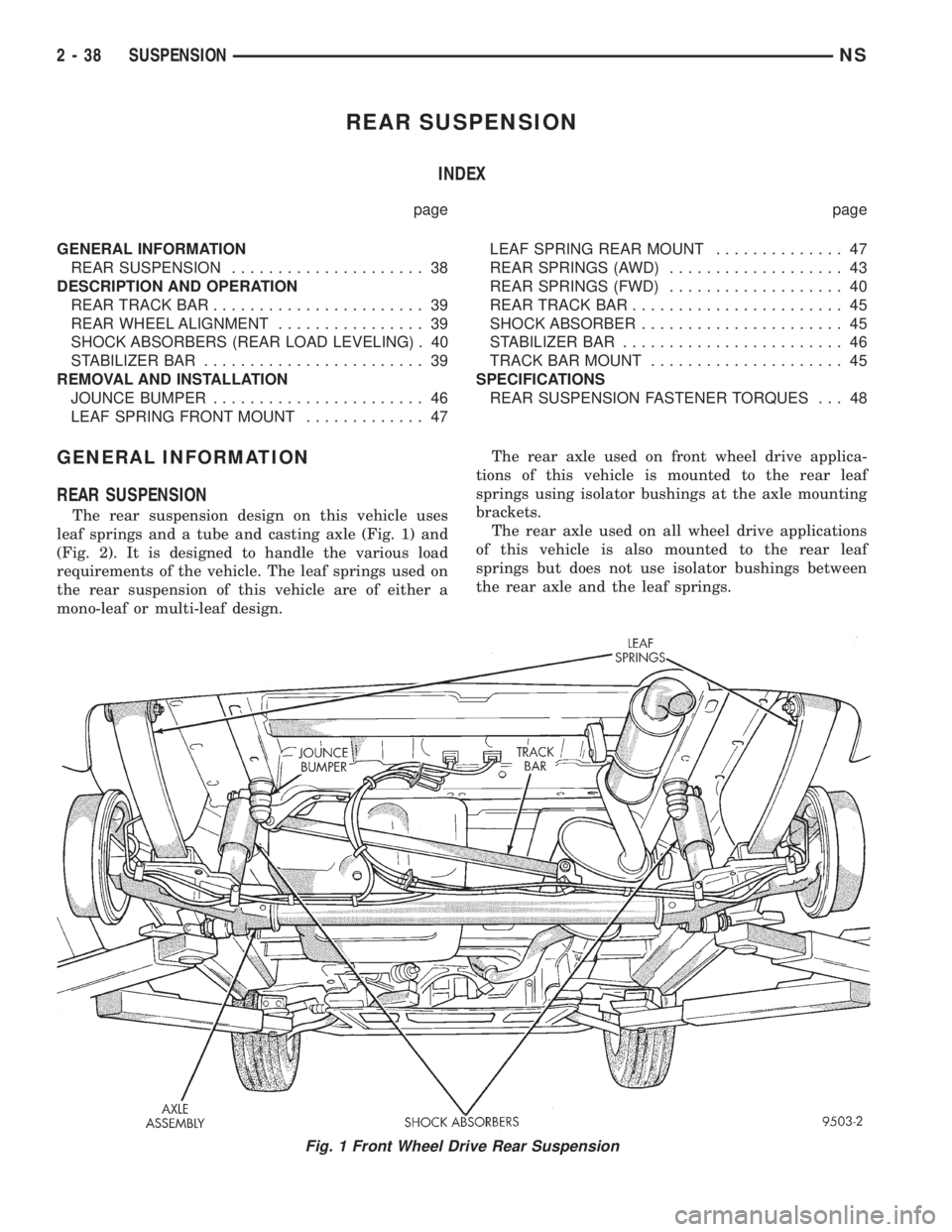
REAR SUSPENSION
INDEX
page page
GENERAL INFORMATION
REAR SUSPENSION..................... 38
DESCRIPTION AND OPERATION
REAR TRACK BAR....................... 39
REAR WHEEL ALIGNMENT................ 39
SHOCK ABSORBERS (REAR LOAD LEVELING) . 40
STABILIZER BAR........................ 39
REMOVAL AND INSTALLATION
JOUNCE BUMPER....................... 46
LEAF SPRING FRONT MOUNT............. 47LEAF SPRING REAR MOUNT.............. 47
REAR SPRINGS (AWD)................... 43
REAR SPRINGS (FWD)................... 40
REAR TRACK BAR....................... 45
SHOCK ABSORBER...................... 45
STABILIZER BAR........................ 46
TRACK BAR MOUNT..................... 45
SPECIFICATIONS
REAR SUSPENSION FASTENER TORQUES . . . 48
GENERAL INFORMATION
REAR SUSPENSION
The rear suspension design on this vehicle uses
leaf springs and a tube and casting axle (Fig. 1) and
(Fig. 2). It is designed to handle the various load
requirements of the vehicle. The leaf springs used on
the rear suspension of this vehicle are of either a
mono-leaf or multi-leaf design.The rear axle used on front wheel drive applica-
tions of this vehicle is mounted to the rear leaf
springs using isolator bushings at the axle mounting
brackets.
The rear axle used on all wheel drive applications
of this vehicle is also mounted to the rear leaf
springs but does not use isolator bushings between
the rear axle and the leaf springs.
Fig. 1 Front Wheel Drive Rear Suspension
2 - 38 SUSPENSIONNS
Page 72 of 1938
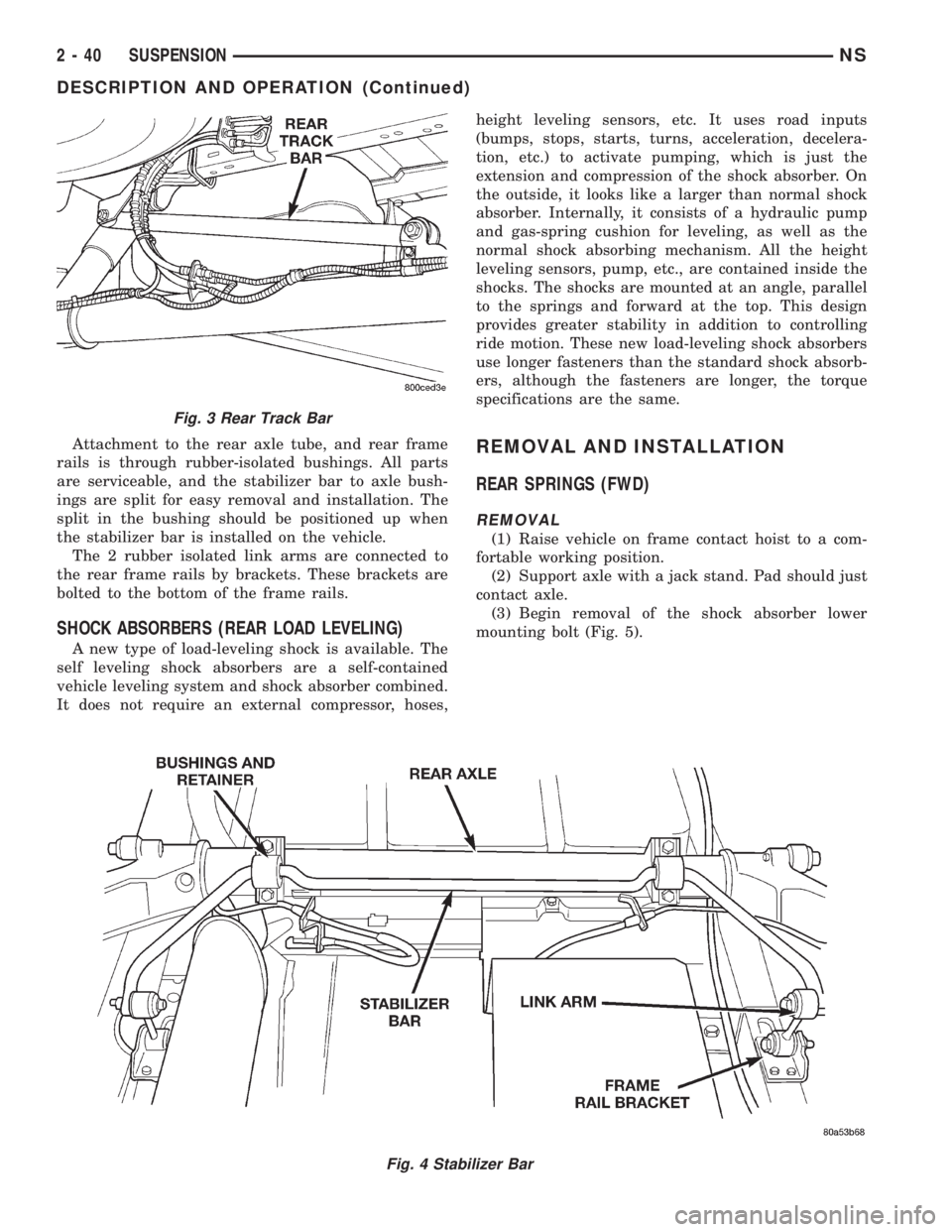
Attachment to the rear axle tube, and rear frame
rails is through rubber-isolated bushings. All parts
are serviceable, and the stabilizer bar to axle bush-
ings are split for easy removal and installation. The
split in the bushing should be positioned up when
the stabilizer bar is installed on the vehicle.
The 2 rubber isolated link arms are connected to
the rear frame rails by brackets. These brackets are
bolted to the bottom of the frame rails.
SHOCK ABSORBERS (REAR LOAD LEVELING)
A new type of load-leveling shock is available. The
self leveling shock absorbers are a self-contained
vehicle leveling system and shock absorber combined.
It does not require an external compressor, hoses,height leveling sensors, etc. It uses road inputs
(bumps, stops, starts, turns, acceleration, decelera-
tion, etc.) to activate pumping, which is just the
extension and compression of the shock absorber. On
the outside, it looks like a larger than normal shock
absorber. Internally, it consists of a hydraulic pump
and gas-spring cushion for leveling, as well as the
normal shock absorbing mechanism. All the height
leveling sensors, pump, etc., are contained inside the
shocks. The shocks are mounted at an angle, parallel
to the springs and forward at the top. This design
provides greater stability in addition to controlling
ride motion. These new load-leveling shock absorbers
use longer fasteners than the standard shock absorb-
ers, although the fasteners are longer, the torque
specifications are the same.
REMOVAL AND INSTALLATION
REAR SPRINGS (FWD)
REMOVAL
(1) Raise vehicle on frame contact hoist to a com-
fortable working position.
(2) Support axle with a jack stand. Pad should just
contact axle.
(3) Begin removal of the shock absorber lower
mounting bolt (Fig. 5).
Fig. 4 Stabilizer Bar
Fig. 3 Rear Track Bar
2 - 40 SUSPENSIONNS
DESCRIPTION AND OPERATION (Continued)
Page 74 of 1938
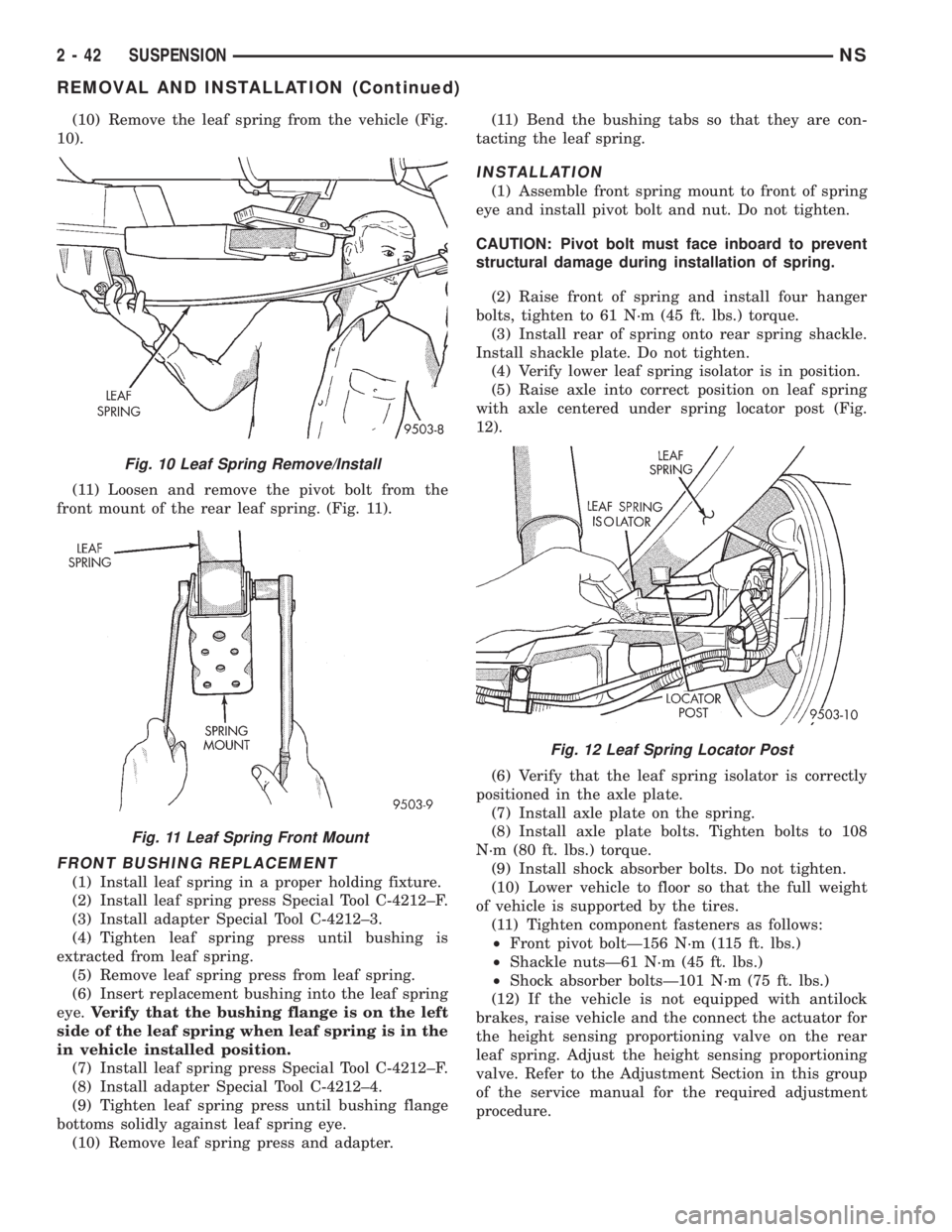
(10) Remove the leaf spring from the vehicle (Fig.
10).
(11) Loosen and remove the pivot bolt from the
front mount of the rear leaf spring. (Fig. 11).
FRONT BUSHING REPLACEMENT
(1) Install leaf spring in a proper holding fixture.
(2) Install leaf spring press Special Tool C-4212±F.
(3) Install adapter Special Tool C-4212±3.
(4) Tighten leaf spring press until bushing is
extracted from leaf spring.
(5) Remove leaf spring press from leaf spring.
(6) Insert replacement bushing into the leaf spring
eye.Verify that the bushing flange is on the left
side of the leaf spring when leaf spring is in the
in vehicle installed position.
(7) Install leaf spring press Special Tool C-4212±F.
(8) Install adapter Special Tool C-4212±4.
(9) Tighten leaf spring press until bushing flange
bottoms solidly against leaf spring eye.
(10) Remove leaf spring press and adapter.(11) Bend the bushing tabs so that they are con-
tacting the leaf spring.
INSTALLATION
(1) Assemble front spring mount to front of spring
eye and install pivot bolt and nut. Do not tighten.
CAUTION: Pivot bolt must face inboard to prevent
structural damage during installation of spring.
(2) Raise front of spring and install four hanger
bolts, tighten to 61 N´m (45 ft. lbs.) torque.
(3) Install rear of spring onto rear spring shackle.
Install shackle plate. Do not tighten.
(4) Verify lower leaf spring isolator is in position.
(5) Raise axle into correct position on leaf spring
with axle centered under spring locator post (Fig.
12).
(6) Verify that the leaf spring isolator is correctly
positioned in the axle plate.
(7) Install axle plate on the spring.
(8) Install axle plate bolts. Tighten bolts to 108
N´m (80 ft. lbs.) torque.
(9) Install shock absorber bolts. Do not tighten.
(10) Lower vehicle to floor so that the full weight
of vehicle is supported by the tires.
(11) Tighten component fasteners as follows:
²Front pivot boltÐ156 N´m (115 ft. lbs.)
²Shackle nutsÐ61 N´m (45 ft. lbs.)
²Shock absorber boltsÐ101 N´m (75 ft. lbs.)
(12) If the vehicle is not equipped with antilock
brakes, raise vehicle and the connect the actuator for
the height sensing proportioning valve on the rear
leaf spring. Adjust the height sensing proportioning
valve. Refer to the Adjustment Section in this group
of the service manual for the required adjustment
procedure.
Fig. 10 Leaf Spring Remove/Install
Fig. 11 Leaf Spring Front Mount
Fig. 12 Leaf Spring Locator Post
2 - 42 SUSPENSIONNS
REMOVAL AND INSTALLATION (Continued)
Page 76 of 1938
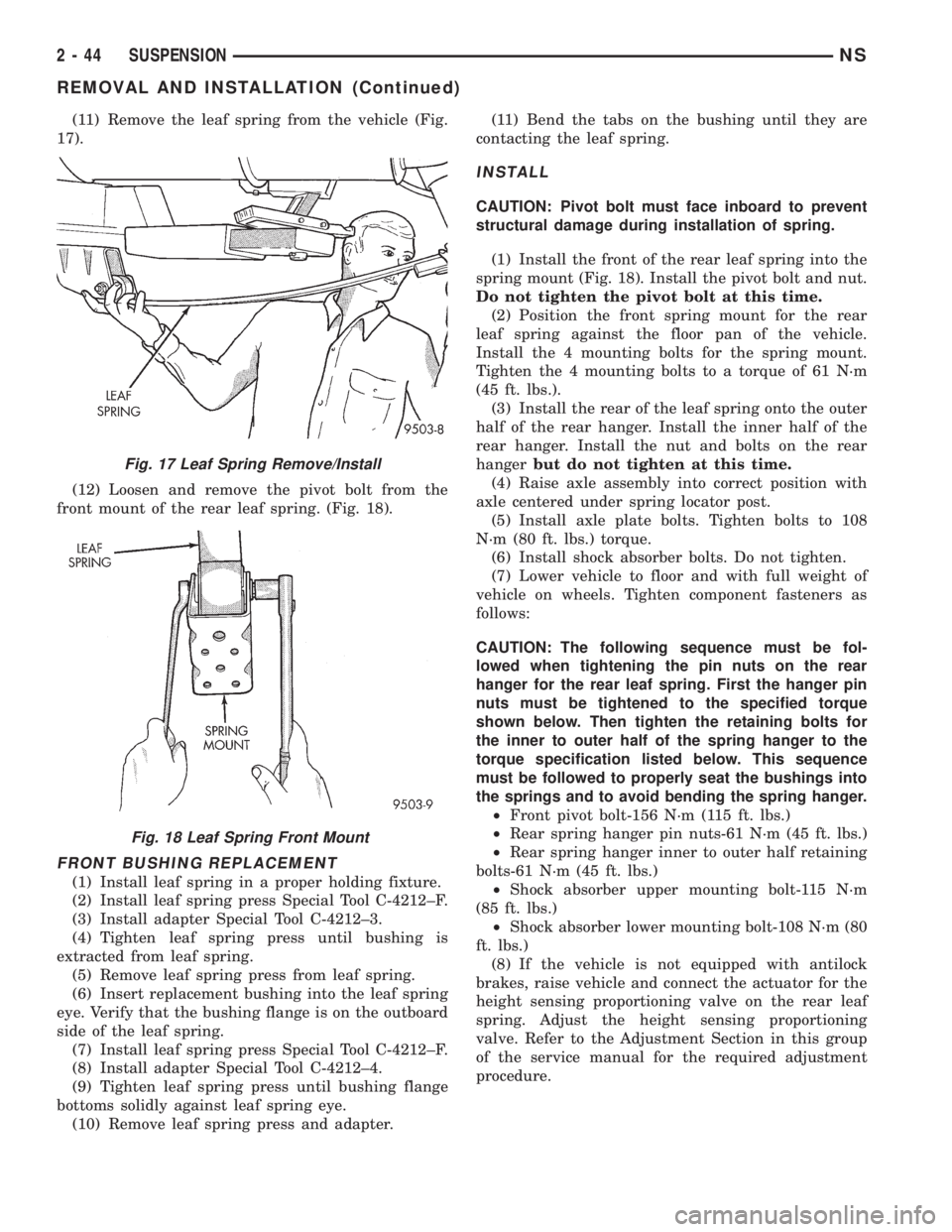
(11) Remove the leaf spring from the vehicle (Fig.
17).
(12) Loosen and remove the pivot bolt from the
front mount of the rear leaf spring. (Fig. 18).
FRONT BUSHING REPLACEMENT
(1) Install leaf spring in a proper holding fixture.
(2) Install leaf spring press Special Tool C-4212±F.
(3) Install adapter Special Tool C-4212±3.
(4) Tighten leaf spring press until bushing is
extracted from leaf spring.
(5) Remove leaf spring press from leaf spring.
(6) Insert replacement bushing into the leaf spring
eye. Verify that the bushing flange is on the outboard
side of the leaf spring.
(7) Install leaf spring press Special Tool C-4212±F.
(8) Install adapter Special Tool C-4212±4.
(9) Tighten leaf spring press until bushing flange
bottoms solidly against leaf spring eye.
(10) Remove leaf spring press and adapter.(11) Bend the tabs on the bushing until they are
contacting the leaf spring.
INSTALL
CAUTION: Pivot bolt must face inboard to prevent
structural damage during installation of spring.
(1) Install the front of the rear leaf spring into the
spring mount (Fig. 18). Install the pivot bolt and nut.
Do not tighten the pivot bolt at this time.
(2) Position the front spring mount for the rear
leaf spring against the floor pan of the vehicle.
Install the 4 mounting bolts for the spring mount.
Tighten the 4 mounting bolts to a torque of 61 N´m
(45 ft. lbs.).
(3) Install the rear of the leaf spring onto the outer
half of the rear hanger. Install the inner half of the
rear hanger. Install the nut and bolts on the rear
hangerbut do not tighten at this time.
(4) Raise axle assembly into correct position with
axle centered under spring locator post.
(5) Install axle plate bolts. Tighten bolts to 108
N´m (80 ft. lbs.) torque.
(6) Install shock absorber bolts. Do not tighten.
(7) Lower vehicle to floor and with full weight of
vehicle on wheels. Tighten component fasteners as
follows:
CAUTION: The following sequence must be fol-
lowed when tightening the pin nuts on the rear
hanger for the rear leaf spring. First the hanger pin
nuts must be tightened to the specified torque
shown below. Then tighten the retaining bolts for
the inner to outer half of the spring hanger to the
torque specification listed below. This sequence
must be followed to properly seat the bushings into
the springs and to avoid bending the spring hanger.
²Front pivot bolt-156 N´m (115 ft. lbs.)
²Rear spring hanger pin nuts-61 N´m (45 ft. lbs.)
²Rear spring hanger inner to outer half retaining
bolts-61 N´m (45 ft. lbs.)
²Shock absorber upper mounting bolt-115 N´m
(85 ft. lbs.)
²Shock absorber lower mounting bolt-108 N´m (80
ft. lbs.)
(8) If the vehicle is not equipped with antilock
brakes, raise vehicle and connect the actuator for the
height sensing proportioning valve on the rear leaf
spring. Adjust the height sensing proportioning
valve. Refer to the Adjustment Section in this group
of the service manual for the required adjustment
procedure.
Fig. 17 Leaf Spring Remove/Install
Fig. 18 Leaf Spring Front Mount
2 - 44 SUSPENSIONNS
REMOVAL AND INSTALLATION (Continued)
Page 77 of 1938

SHOCK ABSORBER
REMOVE/INSTALL
(1) Raise vehicle. Vehicle is to be raised and sup-
ported on jackstands or on a frame contact type
hoist. See Hoisting in the Lubrication And Mainte-
nance section of this service manual.
(2) Support the rear axle of the vehicle using 2
jackstands positioned at the outer ends of the axle.
NOTE: If the shock absorber lower mounting bolt
deflects upward during removal, raise axle by
adjusting the support jack. If the lower shock
absorber bolt deflects downward during removal,
lower the axle by adjusting the support jack.
(3) Remove the shock absorber lower mounting
bolt.
(4) While holding shock absorber, remove the
shock absorber upper mounting bolt.
(5) To install the shock absorber use the reverse
sequence of its removal.
(6) Lower the vehicle to the ground so the full
weight of the vehicle is supported by the suspension.
(7) Tighten the upper and lower shock absorber
mounting bolt to their specified torques.
REAR TRACK BAR
REMOVE
(1) Remove the nut and bolt mounting the track
bar to the rear axle (Fig. 19).
(2) Remove the nut and bolt attaching the track
bar to the track bar mount on the body of the vehicle.
Remove the track bar from the track bar mount.
INSTALL
(1) Install the track bar first into the body mount
for the track bar (Fig. 20). Install the track bar boltwith the head of the bolt facing toward the rear of
the vehicle (Fig. 21). Do not tighten.
(2) Install the track bar into its mounting bracket
on the rear axle (Fig. 19). Install the track bar bolt
with the head of the bolt facing toward the rear of
the vehicle. Do not tighten.
(3) Lower the vehicle to the ground until the full
weight of the vehicle is supported by the wheels.
Tighten both track bar attaching bolts to a torque of
95 N´m (70 ft. lbs.).
TRACK BAR MOUNT
REMOVE
(1) Remove the track bar from the track bar
mount.
(2) Remove the three bolts attaching the track bar
mount to the body (Fig. 22).
Fig. 19 Track Bar Mounting To Axle
Fig. 20 Track Bar Installation
Fig. 21 Track Bar Bolt Installation
NSSUSPENSION 2 - 45
REMOVAL AND INSTALLATION (Continued)
Page 78 of 1938
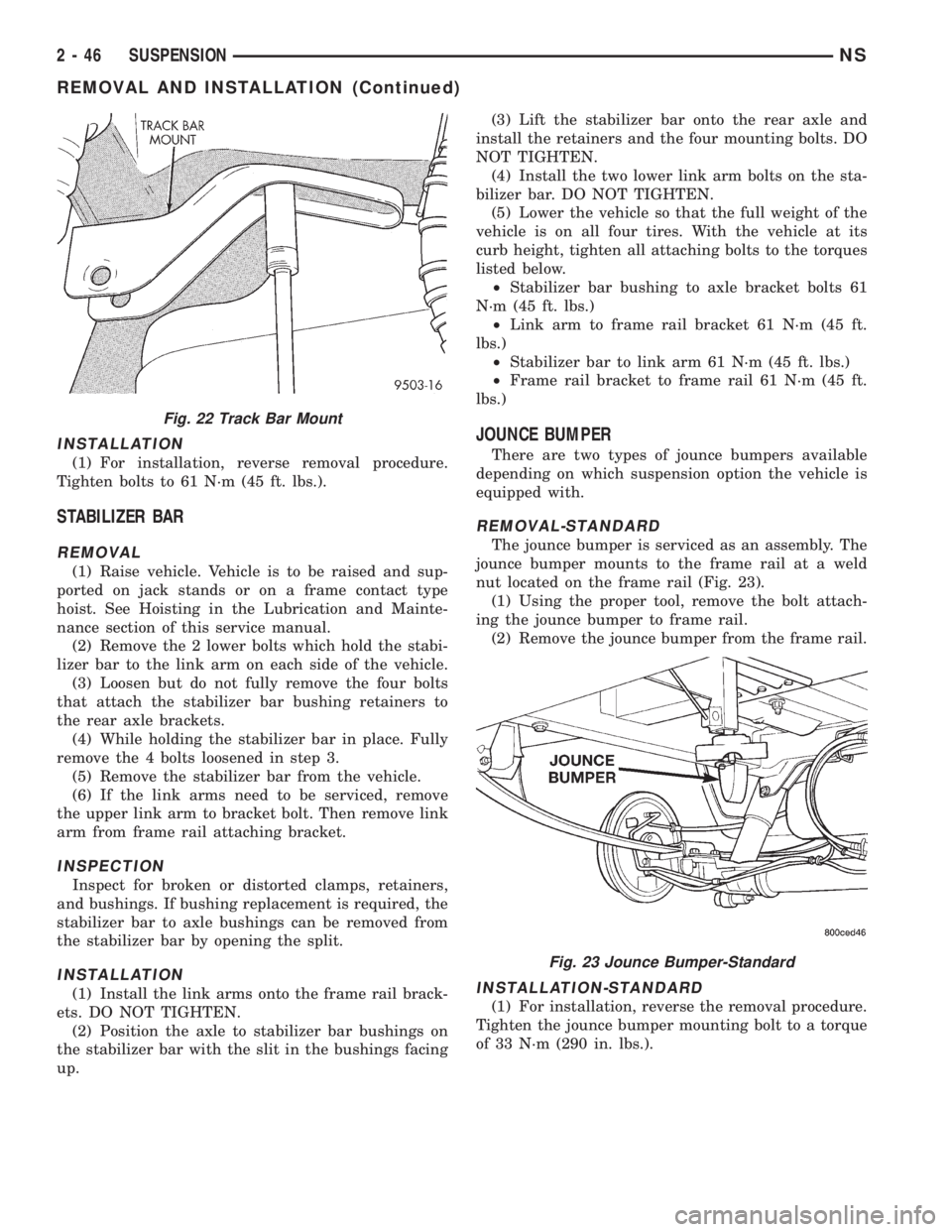
INSTALLATION
(1) For installation, reverse removal procedure.
Tighten bolts to 61 N´m (45 ft. lbs.).
STABILIZER BAR
REMOVAL
(1) Raise vehicle. Vehicle is to be raised and sup-
ported on jack stands or on a frame contact type
hoist. See Hoisting in the Lubrication and Mainte-
nance section of this service manual.
(2) Remove the 2 lower bolts which hold the stabi-
lizer bar to the link arm on each side of the vehicle.
(3) Loosen but do not fully remove the four bolts
that attach the stabilizer bar bushing retainers to
the rear axle brackets.
(4) While holding the stabilizer bar in place. Fully
remove the 4 bolts loosened in step 3.
(5) Remove the stabilizer bar from the vehicle.
(6) If the link arms need to be serviced, remove
the upper link arm to bracket bolt. Then remove link
arm from frame rail attaching bracket.
INSPECTION
Inspect for broken or distorted clamps, retainers,
and bushings. If bushing replacement is required, the
stabilizer bar to axle bushings can be removed from
the stabilizer bar by opening the split.
INSTALLATION
(1) Install the link arms onto the frame rail brack-
ets. DO NOT TIGHTEN.
(2) Position the axle to stabilizer bar bushings on
the stabilizer bar with the slit in the bushings facing
up.(3) Lift the stabilizer bar onto the rear axle and
install the retainers and the four mounting bolts. DO
NOT TIGHTEN.
(4) Install the two lower link arm bolts on the sta-
bilizer bar. DO NOT TIGHTEN.
(5) Lower the vehicle so that the full weight of the
vehicle is on all four tires. With the vehicle at its
curb height, tighten all attaching bolts to the torques
listed below.
²Stabilizer bar bushing to axle bracket bolts 61
N´m (45 ft. lbs.)
²Link arm to frame rail bracket 61 N´m (45 ft.
lbs.)
²Stabilizer bar to link arm 61 N´m (45 ft. lbs.)
²Frame rail bracket to frame rail 61 N´m (45 ft.
lbs.)
JOUNCE BUMPER
There are two types of jounce bumpers available
depending on which suspension option the vehicle is
equipped with.
REMOVAL-STANDARD
The jounce bumper is serviced as an assembly. The
jounce bumper mounts to the frame rail at a weld
nut located on the frame rail (Fig. 23).
(1) Using the proper tool, remove the bolt attach-
ing the jounce bumper to frame rail.
(2) Remove the jounce bumper from the frame rail.
INSTALLATION-STANDARD
(1) For installation, reverse the removal procedure.
Tighten the jounce bumper mounting bolt to a torque
of 33 N´m (290 in. lbs.).
Fig. 22 Track Bar Mount
Fig. 23 Jounce Bumper-Standard
2 - 46 SUSPENSIONNS
REMOVAL AND INSTALLATION (Continued)
Page 79 of 1938
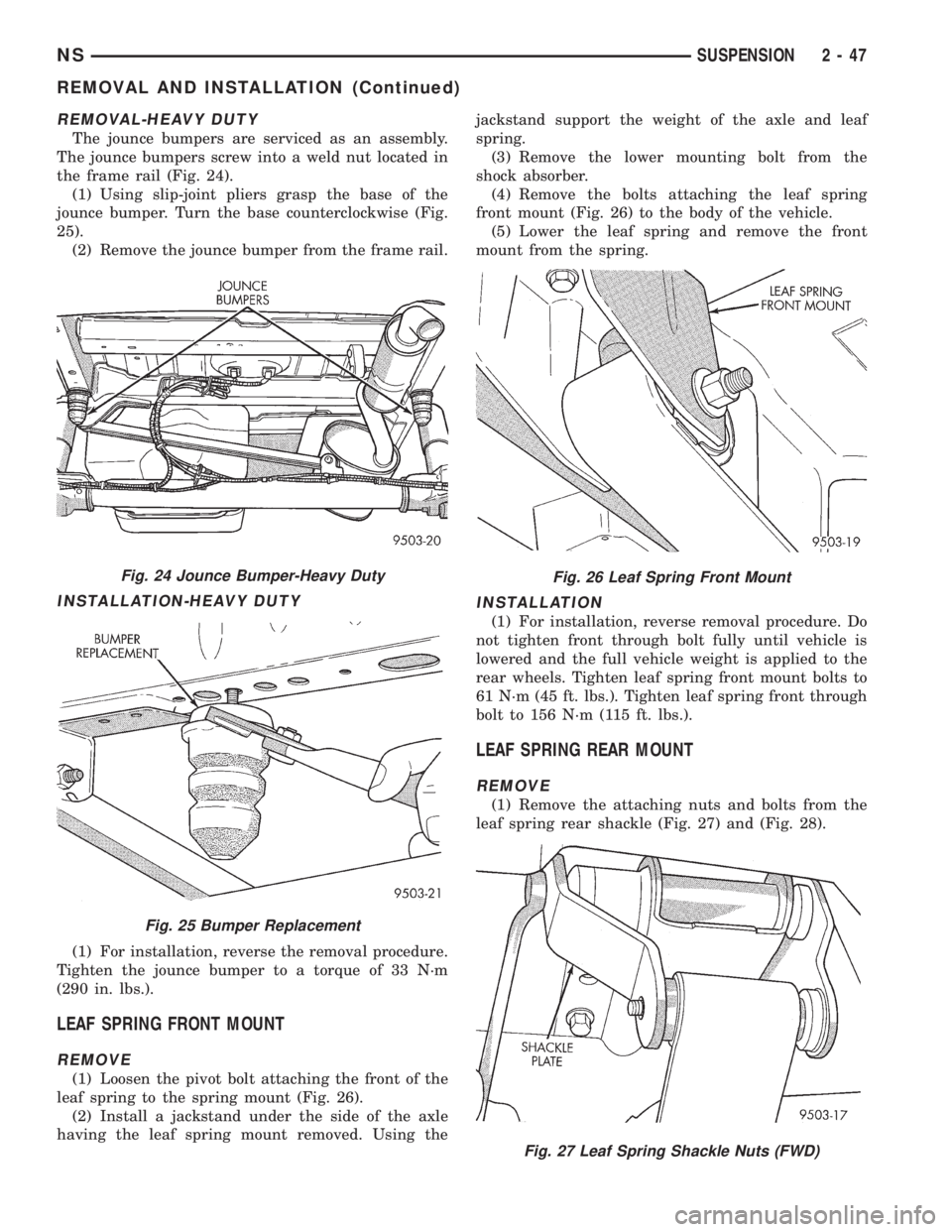
REMOVAL-HEAVY DUTY
The jounce bumpers are serviced as an assembly.
The jounce bumpers screw into a weld nut located in
the frame rail (Fig. 24).
(1) Using slip-joint pliers grasp the base of the
jounce bumper. Turn the base counterclockwise (Fig.
25).
(2) Remove the jounce bumper from the frame rail.
INSTALLATION-HEAVY DUTY
(1) For installation, reverse the removal procedure.
Tighten the jounce bumper to a torque of 33 N´m
(290 in. lbs.).
LEAF SPRING FRONT MOUNT
REMOVE
(1) Loosen the pivot bolt attaching the front of the
leaf spring to the spring mount (Fig. 26).
(2) Install a jackstand under the side of the axle
having the leaf spring mount removed. Using thejackstand support the weight of the axle and leaf
spring.
(3) Remove the lower mounting bolt from the
shock absorber.
(4) Remove the bolts attaching the leaf spring
front mount (Fig. 26) to the body of the vehicle.
(5) Lower the leaf spring and remove the front
mount from the spring.
INSTALLATION
(1) For installation, reverse removal procedure. Do
not tighten front through bolt fully until vehicle is
lowered and the full vehicle weight is applied to the
rear wheels. Tighten leaf spring front mount bolts to
61 N´m (45 ft. lbs.). Tighten leaf spring front through
bolt to 156 N´m (115 ft. lbs.).
LEAF SPRING REAR MOUNT
REMOVE
(1) Remove the attaching nuts and bolts from the
leaf spring rear shackle (Fig. 27) and (Fig. 28).
Fig. 24 Jounce Bumper-Heavy Duty
Fig. 25 Bumper Replacement
Fig. 26 Leaf Spring Front Mount
Fig. 27 Leaf Spring Shackle Nuts (FWD)
NSSUSPENSION 2 - 47
REMOVAL AND INSTALLATION (Continued)